#Lunar Excursion Module
Explore tagged Tumblr posts
Text
GETTING TO THE MOON

On the Apollo missions, the lunar module was in a compartment stage beneath the command module engines. Once the ship had reached a certain distance, that stage would separate and free the lunar module.

The command module would then dock with the lunar module. The spacecraft then continued on to lunar orbit in thesis configuration.
Upon arrival at the separation point, two astronauts would crawl through a pressurized tunnel from the command module into the lunar module. The third astronaut remained in the command module, orbiting above the moon.

The lunar module then separated and proceeded to its landing point. The lunar module (or LEM - Lunar Excursion Module, as it was referred to at this point) became home for the two astronauts during their brief stay on the moon.
-Apollo 11 stayed 21 hrs 36 mins
-Apollo 12 stayed 31.6 hrs
-Apollo 13 never landed
-Apollo 14 stayed 33 hrs
-Apollo 15 stayed 67 hrs
-Apollo 16 stayed 71 hrs
-Apollo 17 (the last men on the Moon) stayed just seconds shy of 75 hrs.

For departure the top half of the LEM, or ascent stage, would fire its rockets and ascend into lunar orbit to rendezvous with the command module. The descent stage was left behind on the lunar surface.
Once the ascent stage had docked with the command module the astronauts would transfer back. The ascent stage was then jettisoned, and all three astronauts rode the command module back to Earth to splashdown somewhere in the ocean.
Just a reminder of what REAL astronauts experienced back in the day. Meanwhile, in present times, everyone seems to be going ga-ga over a bunch of celebrities who central high and experienced a brief moment of zero-G.
#Apollo#command module#lunar module#LEM#Lunar Excursion Module#moon landing#it's real!#NASA#space travel#real space travel
9 notes
·
View notes
Text

LEM after liftoff
42 notes
·
View notes
Text



My CGI early Grumman Apollo LEM, and what it's supposed to look like
#spaceship#spacecraft#apollo#LEM#lunar excursion module#lunar module#lunar lander#space race#space exploration
7 notes
·
View notes
Video
fut-lnr_v_bw_o_n (ca. 1961, unnumbered press photo) by Mike Acs Via Flickr: “Wonders of the Universe: Scientists ‘Tailoring…?’ Within the next 12 months, either a Project Mercury astronaut or his Russian counterpart will be orbiting the earth. Yet, even at this late date, no suitable space suit has been developed which would permit the astronaut to move freely into the hostile environment of space outside the satellite or around on the lunar surface. While in the past, the problem of designing an acceptable space suit was not considered difficult, as the time approaches when the suit should become operational it no longer appears an easy task. To point up the difficulty of this problem, at least three companies are engaged actively in trying to design a suit to cope with space conditions.” At this point, unfortunately, the affixed newspaper caption has been cut off…aaargh. I would’ve loved to have read the rest of it! I I wish there was a repository of Dr. Levitt’s “Wonders of the Universe” articles. And if there is, I haven’t found it. There are too many wonderful, quirky, impeccable, amusing, implausible, etc., etc. things going on here to enumerate. John Gorsuch…’nuff said. Enjoy.
#black and white#Glossy Photo#Artist’s Concept#Artist’s Rendering#Artist's Conception#Artist's Depiction#Artist Concept#Artist Rendering#Artist Conception#artist depiction#Lunar Surface#Lunar Lander#Lunar Landing#Lunar Module#Lunar Excursion Module#Cargo Lunar Excursion Module#lunar spacecraft#Extravehicular Activity#moonwalking#Moonwalkers#Moonwalk#Manned Spacecraft#Manned Space Flight#Human Space Flight#NASA Spacecraft#NASA#NASA Astronaut#NASA Astronauts#Footprints on the moon#boot prints on the moon
3 notes
·
View notes
Text
Apollo program

246 notes
·
View notes
Text

LEM with astronaut suit
#LEM#Lunar excursion module#astronaut#moon landing#lunar exploration#museum exhibit#San Diego Air and Space Museum#balboa park#san diego county#san diego#california#photo#digital#original photographers
0 notes
Text

im goated
ignore inanimate insanity 😇 I'm not the proudest that's number five
#spotify wrapped#not art#anyways stan baby metal#AND LUNAR EXCURSION MODULE even though the weren't up here 👿👿
3 notes
·
View notes
Text
Space

Boeing: Apollo Lunar Excursion Module Proposal, 1962
1 note
·
View note
Text
omg omg okay!!! let's do it




One show: Dimension 20. who do you think I am? i have a sideblog for it jesus
One movie: the Parent Trap 1961. This movie was my childhood. I love Hayley Mills and the mom in this movie saying "electric hips" lives in my head (I do charge rent) Lindsay Lohan version is also good but in my opinion doesn't hold a candle to the og.
One album: One time I was on a discord server and someone threw their soundcloud album into the #self-promo. it was some 15 year old in Tucson who is writing an album for every year of high school. Developing Rabbitlike Tendencies is their second album and I love it. look up lunar excursion module!!
One game: Owinka shooter. what a little game. pretty bare bones and short but so cute and fun. owinka shooter 2 just came out and you can see how much the creator progressed. It would have been Owinka shooter 2 because it's a more fun game but I'm working on beating the world record run for Owinka shooter 1 right now, stealing it from a family friend. also honorable mention to the Lego Batman, lotr, Star wars (complete saga), and Indiana Jones. couldn't help it.
might have thought a bit too hard about this but I love to share my interests especially ones that I think deserve more attention lol
tagged by @nerdfighterfaith thank u thank u got to write paragraphs on my faves
tagging @sugarglazed would love to get to know u better please write paragraphs on your faves
Introduce yourself with:
One TV Show
One Movie
One Album
One Game




I saw this on twitter and thought it was cute 💙
(The game one was hard because games are everything to me and I was struggling between my all time loves 😭 Ocarina of time, Broken Sword, FF7, Mass Effect, Dragon Age, Animal Crossing)
No pressure tagging:
@agaywithcoffee @merryfinches @eddie-redcliffe @soupbtch @spirker @gentlebeardsbarngrill @gentlebeard @xxprincess1x @xoxoemynn @harrylovesspaezle @scorpiostarseed @sherlockig @thought-balloon @theswordnthepen @livwifeofkarl @ofmdee @allthinky @therevengeboys @saltpepperbeard @blueberreads
And anyone else who wants to do it 💖
#WHY IS WRITING ABOUT THINGS YOU LIKE SO EMBARRASSING#i feel so dumb yeah my music is so underground and different#I'M NOT A HIPSTER I JUST LIKE MY STUFF#also i like to feel unique but don't we all bro#having a unique set of 4 and life experiences that color who you are for ppl to get to know you better is the whole point#teeheeified#teehee!!!#owinka shooter#lunar excursion module#developing rabbitlike tendencies#the parent trap
35 notes
·
View notes
Text

"1962 Boeing Apollo Lunar Excursion Module Proposal, painting by Boeing artist Jack Olson
On July 25, 1962, NASA invited 11 firms to submit proposals for the Lunar Excursion Module (LEM). Of the 11 invited, 9 submitted proposals. The firms that submitted proposals were Lockheed, Boeing, Northrop, Ling-Temco-Vought, Grumman, Douglas, General Dynamics Convair, Republic, and Martin Marietta. Grumman won."
Date: July 25, 1962
Paul Carsola: link
#Lunar Module#NASA#Apollo Program#Lockheed#Boeing#Northrop#Ling-Temco-Vought#Grumman#Douglas#General Dynamics Convair#Republic#Martin Marietta#Concept Art#Moon#July#1962#my post
61 notes
·
View notes
Text
Judith Love Cohen
Aerospace engineer Judith Love Cohen was born in 1933 in Brooklyn, New York. Cohen worked on the Hubble Space Telescope, the Minuteman Missile, and the Tracking and Data Relay Satellite. She is best remembered, however, for her work on the Apollo Program. Cohen was on the team that created the Abort-Guidance in the program's Lunar Excursion Module, the system that brought the Apollo 13 astronauts home safely.
Judith Love Cohen died in 2016 at the age of 82.
13 notes
·
View notes
Text
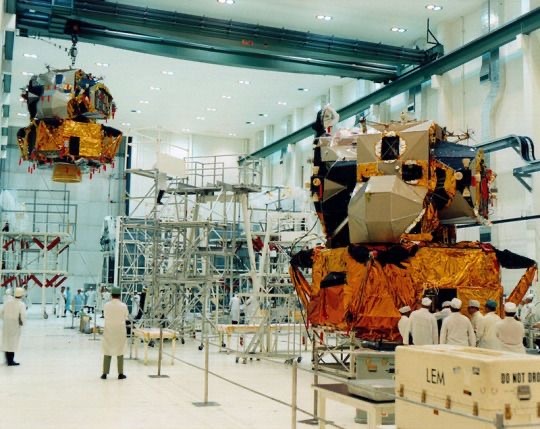
Lunar Excursion Module
37 notes
·
View notes
Text

NASA Marshall fires up hybrid rocket motor to prep for moon landings
NASA's Artemis campaign will use human landing systems, provided by SpaceX and Blue Origin, to safely transport crew to and from the surface of the moon, in preparation for future crewed missions to Mars. As the landers touch down and lift off from the moon, rocket exhaust plumes will affect the top layer of lunar "soil," called regolith, on the moon. When the lander's engines ignite to decelerate prior to touchdown, they could create craters and instability in the area under the lander and send regolith particles flying at high speeds in various directions.
To better understand the physics behind the interaction of exhaust from the commercial human landing systems and the moon's surface, engineers and scientists at NASA's Marshall Space Flight Center in Huntsville, Alabama, recently test-fired a 14-inch hybrid rocket motor more than 30 times. The 3D-printed hybrid rocket motor, developed at Utah State University in Logan, Utah, ignites both solid fuel and a stream of gaseous oxygen to create a powerful stream of rocket exhaust.
"Artemis builds on what we learned from the Apollo missions to the moon. NASA still has more to learn more about how the regolith and surface will be affected when a spacecraft much larger than the Apollo lunar excursion module lands, whether it's on the moon for Artemis or Mars for future missions," said Manish Mehta, Human Landing System Plume & Aero Environments discipline lead engineer.
"Firing a hybrid rocket motor into a simulated lunar regolith field in a vacuum chamber hasn't been achieved in decades. NASA will be able to take the data from the test and scale it up to correspond to flight conditions to help us better understand the physics, and anchor our data models, and ultimately make landing on the moon safer for Artemis astronauts."
Of the 30 test fires performed in NASA Marshall's Component Development Area, 28 were conducted under vacuum conditions and two were conducted under ambient pressure. The testing at Marshall ensures the motor will reliably ignite during plume-surface interaction testing in the 60-ft. vacuum sphere at NASA's Langley Research Center in Hampton, Virginia, later this year.
Once the testing at NASA Marshall is complete, the motor will be shipped to NASA Langley. Test teams at NASA Langley will fire the hybrid motor again but this time into simulated lunar regolith, called Black Point-1, in the 60-foot vacuum sphere. Firing the motor from various heights, engineers will measure the size and shape of craters the rocket exhaust creates as well as the speed and direction the simulated lunar regolith particles travel when the rocket motor exhaust hits them.
"We're bringing back the capability to characterize the effects of rocket engines interacting with the lunar surface through ground testing in a large vacuum chamber—last done in this facility for the Apollo and Viking programs. The landers going to the moon through Artemis are much larger and more powerful, so we need new data to understand the complex physics of landing and ascent," said Ashley Korzun, principal investigator for the plume-surface interaction tests at NASA Langley.
"We'll use the hybrid motor in the second phase of testing to capture data with conditions closely simulating those from a real rocket engine. Our research will reduce risk to the crew, lander, payloads, and surface assets."
Through the Artemis campaign, NASA will send astronauts to explore the moon for scientific discovery, economic benefits, and to build the foundation for the first crewed missions to Mars—for the benefit of all.
4 notes
·
View notes
Text

55 years ago... February 26, 1969 The Apollo 9 astronauts in the very last stages of NASA training and spaceflight preparations. Apollo 9 Command Module Pilot David Scott checks out a 16mm Maurer Motion Picture Camera to be used during the upcoming Apollo mission during which both the Command/Service module, “Gumdrop” built by North American Aviation, and the Lunar Excursion Module, “Spider” built by Grumman aircraft, would be tested for the very first time in Low Earth Orbit. During a break from training for their upcoming space mission, Apollo 9 crew got a haircut before overgoing final procedures & checklists. Each of the astronauts wore a NASA-issued Omega Speedmaster chronograph, David Scott in particular a Speedmaster with a foldable timely bracelet calendar. (Photo: NASA)
#Apollo#Astronaut#321#chronograph#Speedmaster#Omega#MoonwatchUniverse#NASA#Speedytuesday#Moonwatch#military#USAF#US Navy#montres#Uhren#Zulu time
16 notes
·
View notes
Text
Rocket Design Pt.2:
NASA's Saturn V:
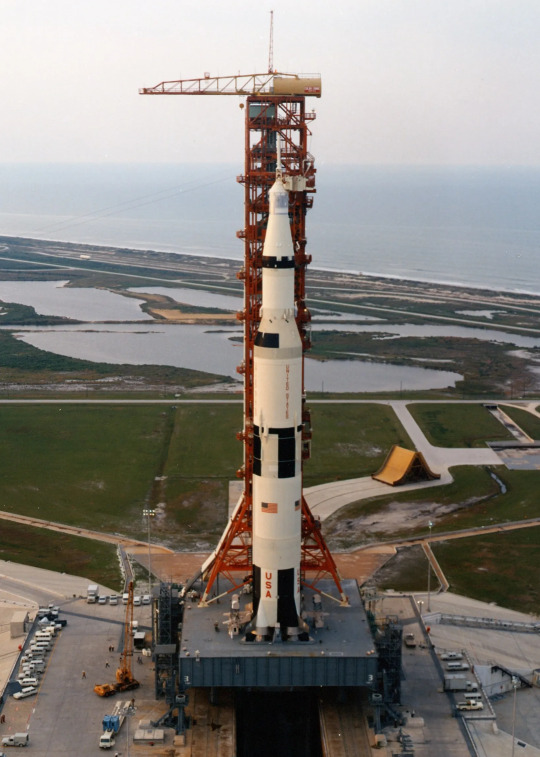
NASA's Saturn V rocket was developed throughout the 60's and was used to get humans to the Moon and back. This led to America winning the space race. The Saturn V used liquid Hydrogen and liquid Oxygen as fuel. While these fuels game the rocket a good specific impulse (efficiency in terms of thrust or fuel consumption), the Hydrogen proved problematic to store. As Hydrogen atoms are the smallest atoms there is (Only consisting of 1 proton and electron), the liquid Hydrogen fuel was prone to leaking. This is still a problem with Hydrogen rockets to this day. It can leak through steel, iron and plastic polymers. These leaks cause launch delays as the leaked Hydrogen would evaporate into flammable and explosive gas. Private companies like SpaceX can afford to take risks, while NASA can't as it is funded by taxes and have to be careful not to put people's tax money at waste. Thankfully, the Saturn V produces water vapour as a result of combusting Hydrogen and Oxygen together.
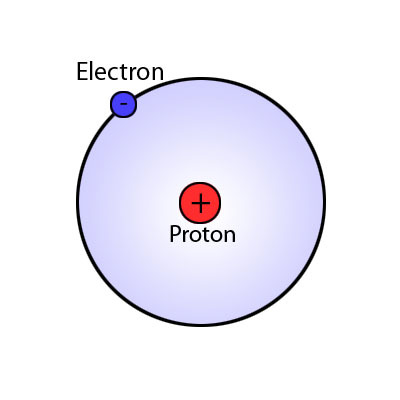
The Saturn V featured a command capsule for three astronauts to be live in for most of the mission. It also featured a lunar lander that only two of the three astronauts can be in at the same time. Both the capsule and the lander had to be docked together for the crew to transfer from one craft to the other.
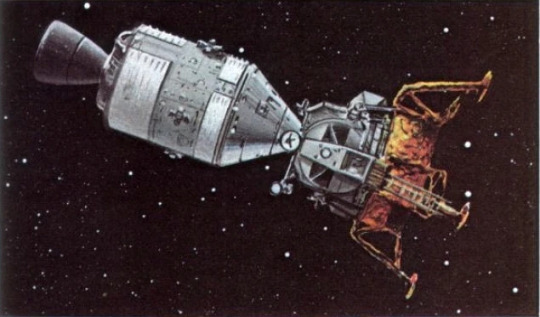
In order to stop the apollo craft from getting too hot, it was made to roll to evenly distribute the heat from the sun around the space craft as there is no air in space to distribute that heat evenly. The gold foil on the landing stage of the lander was to help prevent overheating and act as insulation. Gold is good at dissipating infrared radiation. When the lander took off from the moon to dock with the command capsule, it decoupled from the landing stage and left it behind.
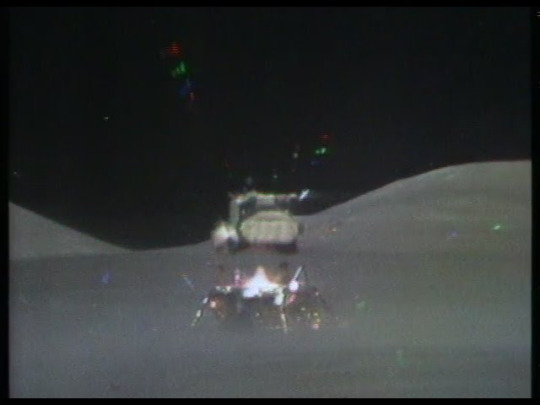
After the two crew members got back in the command module, they ditched the upper stage of the Eagle lander so that its orbit would eventually decay. However, its possible that Apollo 11's Eagle lander cabin is still in orbit after all these years. If so, it might not be much longer.
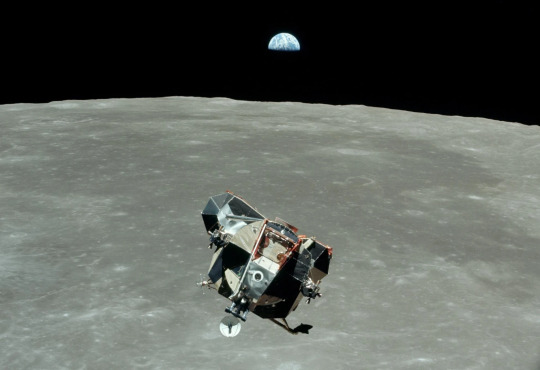
In order for the astronauts to survive re-entry, the Apollo capsule decoupled from its service bay and and used its ablative heatshield attached to the capsule.
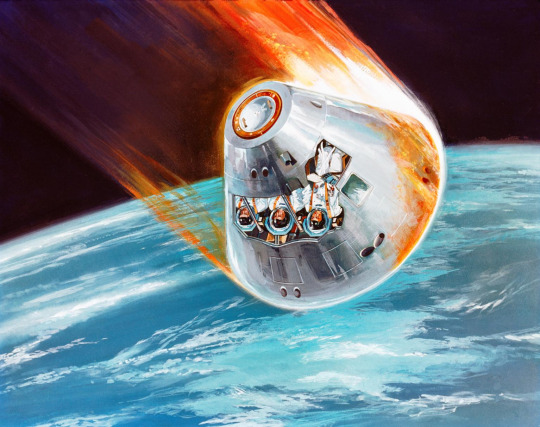
Although the Apollo capsules were recovered after splashdown, they were not reused.
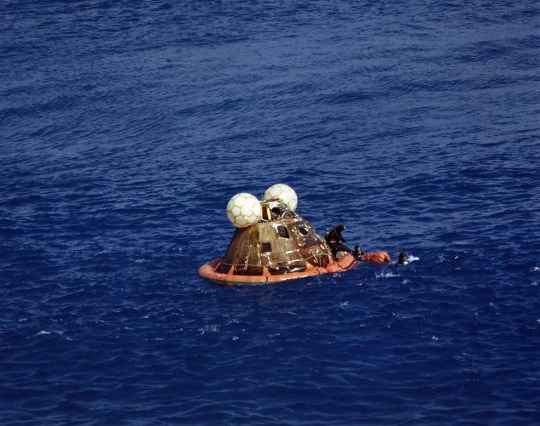
The Saturn V featured 5 engines that became iconic. The engine was called the 'F-1'. The F-1 engine was awfully large considering it was a sea-level engine. The Saturn V used 5 of these engines on its first stage. These engines had these lines inside the engine bells. This was for the cooling method called 'Film cooling'.
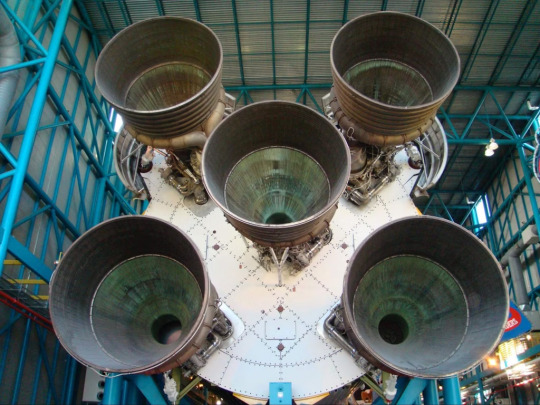
'Film cooling' at 14:20 - 22:15.
youtube
The vacuum engine used on the Apollo service module called 'AJ10-137' used a metal alloy called 'Niobium'. That is the dark bit of the engine seen below. It is strongly reactive to oxygen, meaning that it has to be used in space. It uses the 'Radiative cooling' cooling method. It does this by making the walls of the engine nozzle very thin.
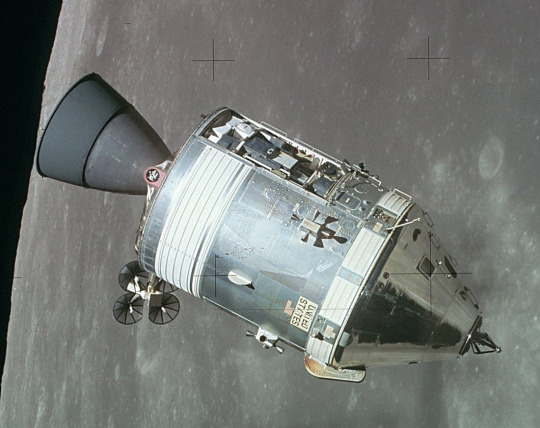
Another interesting fact is that the different Apollo missions had different names for the the Command Service Module.
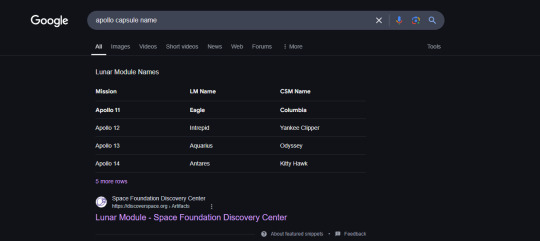
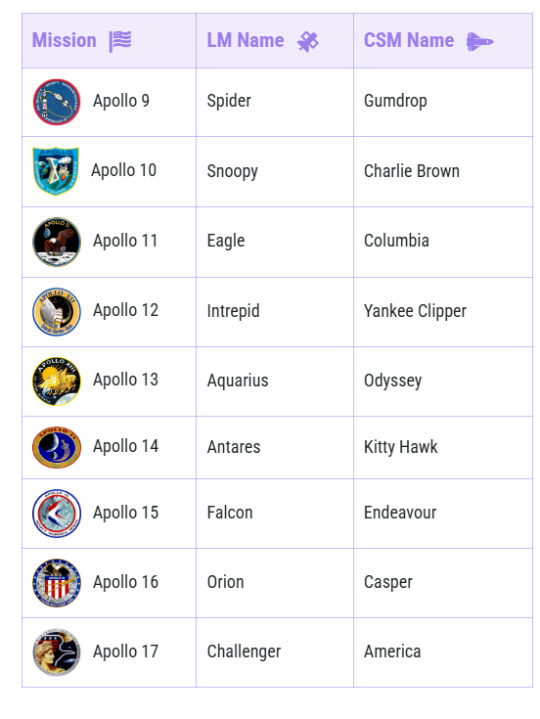
0 notes
Video
youtube
Games reviews of 1971: LEM (Lunar Excursion Module), Huntington Computer...
1 note
·
View note
